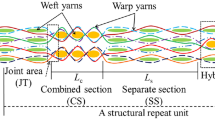Abstract
The energy of impact must decay and be transmitted after a bullet is shot through a ballistic-resistant cloth with a laminate structure. A rigid net structure transmits the impact stress to reduce the breakage of the material in the direction perpendicular to the fabric after the impacting of a projectile. This work combines the rigid net structure of stainless steel mesh with two layers a needle-punched polyamide nonwoven fabric to create a sandwich-like laminate structure. A compound fabric that is composed of a stainless steel mesh and polyamide nonwoven fabrics is placed in multi-layer Kevlar fabrics, and the buffer effect is measured by performing a dropping weight impact test and a bullet-shooting test. The specifications of the stainless steel mesh and the order of placement of the compound fabrics are varied to show the effect of these parameters on the energy of fracture propagation and the buffer effect of the multi-layered Kevlar compound fabric that includes a layer of compound fabric that is made of stainless steel mesh and polyamide nonwoven fabrics. In this study, the compound fabric replaces several layers of Kevlar unidirectional fabric, to be used to reduce the cost of bulletproof vests without reducing ballistic resistance.
Similar content being viewed by others
References
Y. Duana, M. Keefeb, T. A. Bogettic, and B. A. Cheeseman, Int. J. Impact Eng., 31, 996 (2005).
M. Park, J. Yoo, and D.-T. Chung, Int. J. Solids Struct., 42, 123 (2005).
M. O. W. Richardson and M. J. Wisheart, Composites Part A, 27A, 1123 (1996).
V. B. C. Tan, V. P. W. Shim, and T. E. Tay, Int. J. Solids Struct., 40, 6245 (2003).
R. H. Zee and C. Y. Hsieh, Mater. Sci. Eng., A246, 161 (1998).
S. Yadav and G. Ravichandran, Int. J. Impact Eng., 28, 557 (2003).
C. Thanomslip and P. J. Hogg, Compos. Sci. Technol., 63,467 (2003).
Y. Duan, M. Keefe, T. A. Bogetti, and B. A. Cheeseman, Composite Struct., 68, 331 (2005).
NIJ (National Institute of Justice) 0101.04, Body Armor Standard.
Author information
Authors and Affiliations
Corresponding author
Rights and permissions
About this article
Cite this article
Lin, CC., Huang, CC., Chen, YL. et al. Ballistic-resistant stainless steel mesh compound nonwoven fabric. Fibers Polym 9, 761–767 (2008). https://doi.org/10.1007/s12221-008-0119-9
Received:
Revised:
Accepted:
Published:
Issue Date:
DOI: https://doi.org/10.1007/s12221-008-0119-9




